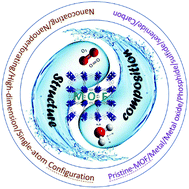Metal–organic frameworks-based catalysts for electrochemical oxygen evolution
Abstract
Engineering highly efficient and cost-effective catalysts for the electrochemical oxygen evolution reaction (OER) is crucial for accelerating the development of renewable energy techniques due to the pivotal role of OER in rechargeable metal–air batteries and water electrolyzers. Recently, porous nonprecious metal catalysts (PNMCs) have received tremendous interest for application in the OER. Metal–organic frameworks (MOFs) built from metal ions and organic linkers have been demonstrated to be promising precursors for preparing PNMCs for the OER owing to their tunable structures/compositions, high surface area and large pore volume. Benefitting from the versatility of compositional/structural modification, MOFs and MOFs-derived PNMCs are robust in generating various high density active sites, which greatly contribute to their electrochemical OER performances. In this review, we first summarize the composition engineering of pristine MOFs and their derivatives, such as heteroatom-doped carbon, metal oxides/phosphides/sulfides/selenides and their hybrids, followed by structural/morphology engineering, including nano-coating and nano-perforating, and the configuration of high-dimensional architecture and single atom sites. Simultaneously, insights toward an in-depth understanding of the actual active sites and the intrinsic mechanism for OER enhancement are highlighted combined with experimental and theoretical studies. Finally, the challenges and perspectives for engineering MOF-based electrocatalysts are addressed.



 Please wait while we load your content...
Please wait while we load your content...